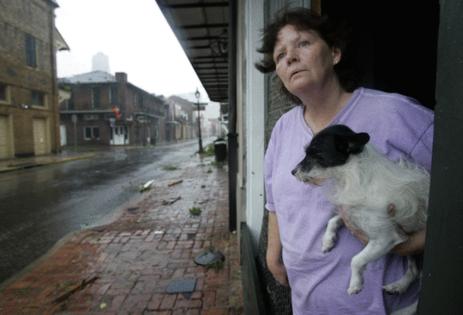Commentary: 20 years after Hurricane Katrina, are our animal companions any safer in a disaster?
Published in Op Eds
On Aug. 29, 2005, Hurricane Katrina made landfall along the Gulf Coast, overwhelming levees and swallowing neighborhoods. The storm displaced some 1.5 million people, claimed over 1,800 human lives and left tens of thousands of animals either deceased or stranded.
Scenes in the media from that time—dogs pacing on rooftops and cats perched on floating furniture or clinging to trees—are seared into our collective consciousness. PETA’s rescue team was able to save some of them, but for many, help came too late—or not at all.
In the wake of Katrina, Congress passed the Pets Evacuation and Transportation Standards (PETS) Act, requiring emergency plans to include provisions for animal companions during disasters. This was an important and overdue step in the right direction, but it wasn’t a complete solution. Two decades and hundreds of other disasters later, many animal guardians and local governments are still unprepared for the next big event.
Whether a slow-building hurricane or a fast-moving wildfire, disasters don’t wait until we are ready. We must ask ourselves: Will our whole family—including our animals—be safe?
According to recent surveys, only about a third of Americans have a disaster preparedness plan that includes animals, leaving people to make an impossible choice: save themselves and leave animals behind or stay and risk dying. Many of us remember images of a young boy sobbing as authorities removed his little dog, Snowball, from his arms before he boarded a bus evacuating families from New Orleans’ Superdome. Animals weren’t allowed, and his parents made the heartrending decision to leave without their beloved dog.
That’s why disaster planning must include our animal companions at every stage. Start by packing a “go bag” long before anything goes wrong. It should contain at least a week’s worth of food and water for each animal, along with any medications, vet and vaccination records, and first aid supplies. It should also include a leash and harness for dogs and a secure carrier for cats and other small animals, as frightened animals often try to flee. Remember litter supplies for cats. Familiar items like toys or blankets help ease stress during displacement.
To help reunite you if you’re accidentally separated, animals should be microchipped and wear collars with up-to-date ID tags. It’s also a good idea to keep recent photos showing you with your animals.
Equally important is knowing in advance where you can go with your animals. Identify animal-friendly hotels, emergency shelters that accept animals, campgrounds, and friends or family who can help. Don’t wait until the sirens start blaring to figure it out—by then, roads may be closed, communication systems down and emergency resources overwhelmed. Tuck a printed list of addresses and phone numbers into your emergency kit.
If authorities force you to evacuate without your animals, never leave them tied up or confined. Rising floodwaters, fire and falling debris can quickly turn deadly. Open fences and stall doors to give animals a fighting chance to escape.
If flooding is likely, move animals to the highest safe location available—preferably an upper floor in your home or any area above predicted flood levels for large animals. Leave enough food and clean water to last at least a week. Use heavy, tip-resistant dishes or multiple smaller bowls in case one gets knocked over.
Post a clear and visible notice on your home’s exterior to alert emergency responders. You can seal your message in a plastic bag and tape it near the front door. The sign should state how many animals are inside, what types they are, their exact location within the home and your contact information.
The next disaster may be years, months, weeks or days away. We cannot control when or where it will happen, but we can control how prepared we are. Because when disaster strikes, it’s too late to wonder what we should have done. And because our animals are counting on us.
____
Melissa Rae Sanger is a licensed veterinary technician and a staff writer for the PETA Foundation, 501 Front St., Norfolk, VA 23510; www.PETA.org.
___
©2025 Tribune Content Agency, LLC.
























































Comments